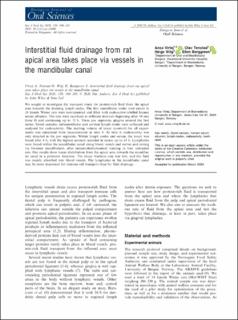| dc.contributor.author | Virtej, Anca | |
| dc.contributor.author | Tenstad, Olav | |
| dc.contributor.author | Wiig, Helge | |
| dc.contributor.author | Berggreen, Ellen | |
| dc.date.accessioned | 2021-04-26T07:44:49Z | |
| dc.date.available | 2021-04-26T07:44:49Z | |
| dc.date.created | 2020-07-29T10:47:32Z | |
| dc.date.issued | 2020 | |
| dc.identifier.issn | 0909-8836 | |
| dc.identifier.uri | https://hdl.handle.net/11250/2739453 | |
| dc.description.abstract | We sought to investigate the transport route for protein‐rich fluid from the apical area towards the draining lymph nodes. The first mandibular molar root canals in 24 female Wistar rats were instrumented and filled with radioactive‐labelled human serum albumin. The rats were sacrificed at different intervals beginning after 10 min (time 0) and continuing up to 72 h. Three jaw segments, gingiva around the first molar, blood samples, submandibular and cervical lymph nodes were collected and analyzed for radioactivity. The starting volume of tracer (control) for all experiments was calculated from measurements at time 0. At time 0, radioactivity was only detected in the jaw segments. Within lymph nodes and serum, the tracer was found after 4 h, with the highest amount recorded in serum up to 24 h. Lymphatics were found within the mandibular canal along blood vessels and nerves and exiting via foramen mandibularis, after immunohistochemical staining in four untreated rats. Our results show tracer distribution from the apical area towards the mandibular canal in a posterior direction. The tracer washout rate was low, and the fluid was mainly absorbed into blood vessels. The lymphatics in the mandibular canal may be more important for immune cell transport than for fluid drainage. | en_US |
| dc.language.iso | eng | en_US |
| dc.publisher | Wiley | en_US |
| dc.rights | Navngivelse 4.0 Internasjonal | * |
| dc.rights.uri | http://creativecommons.org/licenses/by/4.0/deed.no | * |
| dc.title | Interstitial fluid drainage from rat apical area takes place via vessels in the mandibular canal. | en_US |
| dc.type | Journal article | en_US |
| dc.type | Peer reviewed | en_US |
| dc.description.version | publishedVersion | en_US |
| dc.rights.holder | Copyright 2020 The Authors | en_US |
| cristin.ispublished | true | |
| cristin.fulltext | original | |
| cristin.qualitycode | 2 | |
| dc.identifier.doi | 10.1111/eos.12690 | |
| dc.identifier.cristin | 1820836 | |
| dc.source.journal | European Journal of Oral Sciences | en_US |
| dc.source.40 | 128 | |
| dc.source.14 | 3 | |
| dc.source.pagenumber | 190–195 | en_US |
| dc.identifier.citation | European Journal of Oral Sciences. 2020; 128: 190–195 | en_US |
| dc.source.volume | 128 | en_US |

